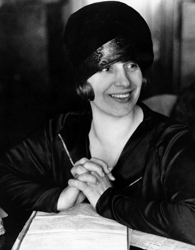Some people see Aimee Semple McPherson as one of the first feminists, while others believe she is one of the 20th century’s greatest spiritual leaders. Her vivacious personality and strongly held beliefs attracted legions of followers, but the end of McPherson’s life was marred by controversy and legal battles.
Aimee Semple McPherson’s Early Days
Aimee Kennedy was born on October 9, 1890, to James and Minnie Kennedy on a farm near Ingersoll, Ontario, Canada. When she was 17, McPherson attended a tent revival with her father. She was profoundly moved by the experience and described feeling “born again” into the Christian faith. She was also deeply affected by the minister, Robert Semple, who pulled her on stage during his sermon. Eight months later, she married him and they began to travel together as missionaries.
Sources in this Story
- American Public Media: Speaking of Faith: Reviving Sister Aimee
- National Park Service: Angelus Temple, Women’s History Month 2002
- The Foursquare Church: Aimee Semple McPherson
- YouTube: Aimee Semple McPherson arrives in New York circa 1920s
- Smithsonian Magazine: The Incredible Disappearing Evangelist
- A Traditional Music Library: Aimee McPherson
McPherson’s Notable Accomplishments
McPherson lost her husband to malaria when she was eight months pregnant; she struggled with her life as a lone missionary with an infant in China. She and her daughter moved back to the United States, where she met and married businessman Harold McPherson. She attempted to achieve domestic bliss, but she found spiritual bliss more alluring. In a vehicle she called “The Gospel Car,” McPherson took to the highways and began to preach at Pentecostal tent revivals across the country.
Crowds flocked to see “Sister Aimee,” who preached of the Holy Spirit, performed faith healings and spoke in tongues. Although her philosophies were based in Pentecostalism, she avoided calling it such, because at that time the Pentecostal faith was not well regarded. After traveling as an itinerant preacher for several years, in 1923 McPherson opened a church in Los Angeles named the Angelus Temple. It was there she founded her own sect of Christianity, The International Church of the Foursquare Gospel.
In 1924, she founded a radio station to broadcast her message and became the first woman to be granted a broadcast license by the Federal Communications Commission. She further diversified her message by taking it to Broadway. She also published a weekly newsletter and a monthly magazine focused on her teachings. During the Great Depression, McPherson ministered to bodies as well as souls, offering hot meals at the Angelus Temple.
Aimee Semple McPherson and her Work
- “Aimee Semple McPherson and the Resurrection of Christian America” by Matthew Avery Sutton
- “Sister Aimee: The Life of Aimee Semple McPherson” by Daniel Mark Epstein
- “Aimee Semple McPherson: Everybody’s Sister” by Edith L. Blumhofer
The Rest of the Story
On May 18, 1926, McPherson vanished while swimming near Venice Beach. Her followers were hysterical at the news and two died searching for her in the California waters. No trace of her could be found, except when police found a ransom note demanding $500,000 for her return.
A month after she disappeared, McPherson was found in the Arizona desert. She claimed to have walked 13 hours from Mexico, where she had been held captive. However, her shoes showed no sign of such a long journey, and although she had been wearing a swimsuit when she disappeared, she reappeared fully clothed. More cracks developed in her story, including eyewitness accounts of her sharing a hotel room with an employee from her radio station.
She was brought to trial and accused of perjury. Despite witness accounts to the contrary, McPherson insisted she had been abducted and the District Attorney eventually dropped the charges. McPherson’s disappearance inspired a song and the incident is still an unsolved mystery today.
The last time anyone saw McPherson alive was in 1944 when she preached to a large crowd in Oakland, California. On September 27, 1944, she was found unconscious in a hotel room containing bottles of very strong sedatives. Her death was ruled an accidental overdose and more than 50,000 people visited her body as it lay in state at Angelus Temple.
This article was originally written by Jennifer Ferris; it was updated October 15, 2017.











